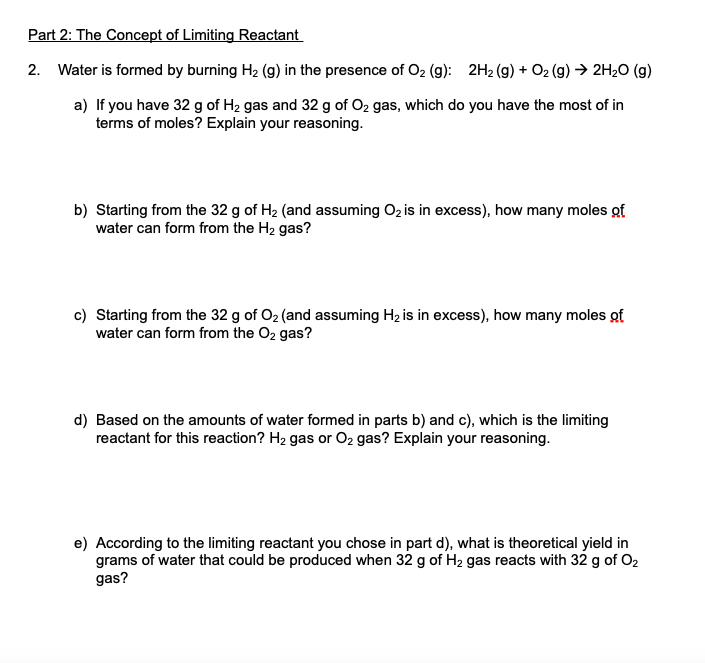Part 2: The Concept of Limiting Reactant 2. Water is formed by burning H2 (g) in the presence of O2 (g): 2H2 (g) + O2 (g) → 2H20 (g) a) If you have 32 g of H2 gas and 32 g of O2 gas, which do you have the most of in terms of moles? Explain your reasoning. b) Starting from the 32 g of H2 (and assuming Oz is in excess), how many moles of water can form from the H2 gas? c) Starting from the 32 g of O2 (and assuming Hz is in excess), how many moles gf water can form from the O2 gas? d) Based on the amounts of water formed in parts b) and c), which is the limiting reactant for this reaction? H2 gas or O2 gas? Explain your reasoning. e) According to the limiting reactant you chose in part d), what is theoretical yield in grams of water that could be produced when 32 g of H2 gas reacts with 32 g of O2 gas?
Part 2: The Concept of Limiting Reactant 2. Water is formed by burning H2 (g) in the presence of O2 (g): 2H2 (g) + O2 (g) → 2H20 (g) a) If you have 32 g of H2 gas and 32 g of O2 gas, which do you have the most of in terms of moles? Explain your reasoning. b) Starting from the 32 g of H2 (and assuming Oz is in excess), how many moles of water can form from the H2 gas? c) Starting from the 32 g of O2 (and assuming Hz is in excess), how many moles gf water can form from the O2 gas? d) Based on the amounts of water formed in parts b) and c), which is the limiting reactant for this reaction? H2 gas or O2 gas? Explain your reasoning. e) According to the limiting reactant you chose in part d), what is theoretical yield in grams of water that could be produced when 32 g of H2 gas reacts with 32 g of O2 gas?
General Chemistry - Standalone book (MindTap Course List)
11th Edition
ISBN:9781305580343
Author:Steven D. Gammon, Ebbing, Darrell Ebbing, Steven D., Darrell; Gammon, Darrell Ebbing; Steven D. Gammon, Darrell D.; Gammon, Ebbing; Steven D. Gammon; Darrell
Publisher:Steven D. Gammon, Ebbing, Darrell Ebbing, Steven D., Darrell; Gammon, Darrell Ebbing; Steven D. Gammon, Darrell D.; Gammon, Ebbing; Steven D. Gammon; Darrell
Chapter3: Calculations With Chemical Formulas And Equaitons
Section: Chapter Questions
Problem 3.20QP: Propane, C3H8, is the fuel of choice in a gas barbecue. When burning, the balanced equation is...
Related questions
Question

Transcribed Image Text:Part 2: The Concept of Limiting Reactant
2. Water is formed by burning H2 (g) in the presence of O2 (g): 2H2 (g) + O2 (g) → 2H20 (g)
a) If you have 32 g of H2 gas and 32 g of O2 gas, which do you have the most of in
terms of moles? Explain your reasoning.
b) Starting from the 32 g of H2 (and assuming Oz is in excess), how many moles of
water can form from the H2 gas?
c) Starting from the 32 g of O2 (and assuming Hz is in excess), how many moles gf
water can form from the O2 gas?
d) Based on the amounts of water formed in parts b) and c), which is the limiting
reactant for this reaction? H2 gas or O2 gas? Explain your reasoning.
e) According to the limiting reactant you chose in part d), what is theoretical yield in
grams of water that could be produced when 32 g of H2 gas reacts with 32 g of O2
gas?
Expert Solution
This question has been solved!
Explore an expertly crafted, step-by-step solution for a thorough understanding of key concepts.
This is a popular solution!
Trending now
This is a popular solution!
Step by step
Solved in 6 steps with 10 images

Recommended textbooks for you

General Chemistry - Standalone book (MindTap Cour…
Chemistry
ISBN:
9781305580343
Author:
Steven D. Gammon, Ebbing, Darrell Ebbing, Steven D., Darrell; Gammon, Darrell Ebbing; Steven D. Gammon, Darrell D.; Gammon, Ebbing; Steven D. Gammon; Darrell
Publisher:
Cengage Learning

Chemistry: Principles and Reactions
Chemistry
ISBN:
9781305079373
Author:
William L. Masterton, Cecile N. Hurley
Publisher:
Cengage Learning

Chemistry for Engineering Students
Chemistry
ISBN:
9781337398909
Author:
Lawrence S. Brown, Tom Holme
Publisher:
Cengage Learning

General Chemistry - Standalone book (MindTap Cour…
Chemistry
ISBN:
9781305580343
Author:
Steven D. Gammon, Ebbing, Darrell Ebbing, Steven D., Darrell; Gammon, Darrell Ebbing; Steven D. Gammon, Darrell D.; Gammon, Ebbing; Steven D. Gammon; Darrell
Publisher:
Cengage Learning

Chemistry: Principles and Reactions
Chemistry
ISBN:
9781305079373
Author:
William L. Masterton, Cecile N. Hurley
Publisher:
Cengage Learning

Chemistry for Engineering Students
Chemistry
ISBN:
9781337398909
Author:
Lawrence S. Brown, Tom Holme
Publisher:
Cengage Learning

Chemistry
Chemistry
ISBN:
9781305957404
Author:
Steven S. Zumdahl, Susan A. Zumdahl, Donald J. DeCoste
Publisher:
Cengage Learning

Chemistry & Chemical Reactivity
Chemistry
ISBN:
9781133949640
Author:
John C. Kotz, Paul M. Treichel, John Townsend, David Treichel
Publisher:
Cengage Learning

Chemistry & Chemical Reactivity
Chemistry
ISBN:
9781337399074
Author:
John C. Kotz, Paul M. Treichel, John Townsend, David Treichel
Publisher:
Cengage Learning